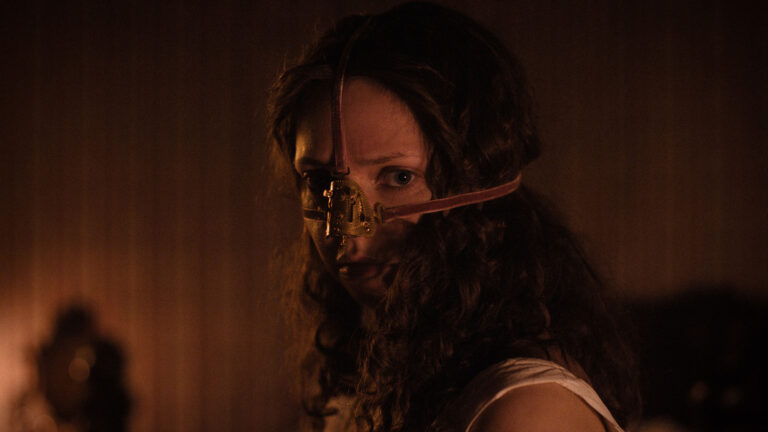As John Lithgow & Olivia Colman broke hearts across town in “Jimpa” and theatregoers bounced to Questlove’s sophomore doc about Sly Stone, the Library theater in Park City got weird. Increasingly the location that the festival employs when they want to show Sundance attendees something a bit off the beaten path, the Park City Library premiered two features that aren’t like anything else in the program.
The better of the two is Emilie Blichfeldt’s “The Ugly Stepsister,” a Shudder original that uses the classic tale of Cinderella in ways that Walt Disney could have never imagined. Inspired by David Cronenberg’s body horror oeuvre, it’s almost a fairy tale sibling to Coralie Fargeat’s “The Substance,” a story of an obsessive quest for female perfection, the tale of a poor girl put through absolute torture to woo a worthless Prince Charming. Once it becomes clear where it’s going, it takes a little too long to get there—there’s a tighter version that doesn’t lose the momentum that this one sometimes does—but it’s an undeniably vicious piece of entertainment, anchored by a fearless, breathtaking performance from Lea Myren as the title character.
Myren plays Elvira, the oldest daughter of the cruel Rebekka (Ane Dahl Torp), who has just married a man she presumed wealthy until discovering on his pre-credits death that he was broke. Elvira has a quietly confident younger sister named Alma (Flo Fagerli), and, of course, they both have a new stepsister named Agnes (Thea Sofie Loch Næss), aka Cinderella. With no money to their name, Rebekka positions Elvira to be the belle of the upcoming ball at the palace, hoping that she can marry their family into money. This means that Elvira has to go a cruel finishing school that bullies her emotionally and physically, placing a heavy emphasis on weight. Elvira gets a nose job that provides an early film warning that this is going to get bad. And then there’s the tapeworm.
With her wonderfully expressive eyes, Myren is a revelation here, carefully maintaining the entire tone of the piece with Blichfeldt. “The Ugly Stepsister” could have been two hours of abject torture, but Myren’s naïve hope that she will be the Princess comes through in every scene, allowing us to root for her as a person instead of just a device in a brutal horror film. The impending ball gives the film an effective ticking clock—we know it’s not going to go well. The only question is how gruesome it’s going to get. (The answer is very.)
Blichfeldt also gets notable assists from her craft team, including production design that teeters brilliantly between realism and fairy tale. And DOP Marcel Zyskind (“The Dead Don’t Hurt”) enhances the production with a look that recalls shot-on-film European horror of the ‘70s and ‘80s.
“The Ugly Stepsister” does have a brutal inevitability that will be a drawback for some people. There’s something soul-crushing about watching poor Elvira get pushed to the brink of mortality for two hours, and I get that being too much for certain viewers, including the one at the premiere who literally vomited into the aisle. Although if you know what you’re getting into, Myren’s performance and the consistently impressive world of the film justify the journey. After all, trying to be a princess can get really ugly.
There’s a similar “not for everyone” tone to Amanda Kramer’s “By Design,” a film that I admire for its sheer audacity more than appreciate for its execution. There are some sharp ideas in “By Design” and one excellent performance, but it often struggles to tie those ideas together in a coherent way, wearing out its welcome long before it’s over. When I left, I told a colleague, “That is a movie for someone but that someone is not me.” And that might sound like evading actual criticism, but I do believe that something as audaciously original as Kramer’s film is also going to be incredibly subjective. It’s like performance art or interpretative dance: Either it speaks to you, or it doesn’t. This one doesn’t quite have enough to say for me.
“By Design” was introduced as having one of Sundance’s best loglines, and it’s certainly an original one. It’s a body swap movie with a piece of furniture. Camille (Juliette Lewis) is a woman who turns into a chair. Yes, literally. After one of her weekly lunches with her friends (Samantha Mathis, Robin Tunney – both solid), the trio goes to a store and Camille spots a gorgeous chair. When she returns the next day to buy it, she’s informed that someone beat her to it, and then, well, Camille’s soul enters the chair. Her body remains at home in a catatonic state that doesn’t seem to bother her friends or her mother, who continue to engage with the lifeless Camille as if nothing’s wrong. Her soul enters the chair, which ends up in the apartment of a man named Olivier (Mamoudou Athie), who basically becomes as infatuated with it as Camille.
What we possess and admire is something that defines us. People often feel like they “must have something” in a register that’s similar to desiring another human being. Kramer takes the sort of sensual obsession we can have with objects to extremes in a film that often breaks into sensual dance numbers and works in a dialogue register that could accurately be called mannered. Credit to Kramer for finding an ensemble who could match her tone, but it’s Athie who really elevates the production, finding a lithe sensuality in his movement that shifts the energy of the film in a more interesting direction that what first feels like little more than a satire of suburban women.
As much as I admire both Athie’s and Kramer’s commitments here, my issue with “By Design” comes down to momentum. It’s a piece that feels like it’s pitched in the same register from the beginning until very near the end, branching off for scenes that could stand alone as effective short films but don’t help build the pace of this one. For example, there’s a phenomenal one with Athie at a dinner party where he brings his special chair that could have been a standalone short; while another one on a balcony with Clifton Collins Jr. felt like it would never end. Scenes struggle to tie together and the whole piece kind of drifted away for me. It might sound cheesy to say that I grew restless in my theater chair, but it would be the truth.

